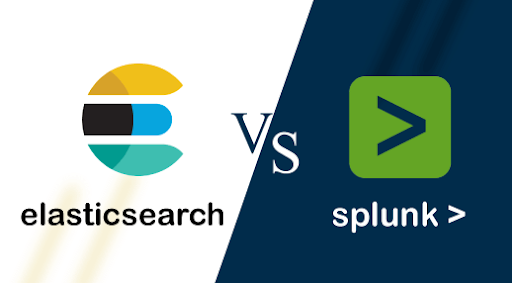Let's Discuss
Enquire NowLog management tools are essential to the security structure of a business. Without them, businesses would scarcely have access to information on the activities and occurrences taking place within their infrastructures that could represent a security risk. Spunk and ELK are two examples of such software that is essential to a company’s tiered security architecture. To decide which tool is better, let’s compare Splunk and ELK side by side.
Let’s start with the basics.

Image Source: https://www.javatpoint.com/elasticsearch-vs-splunk
What is Splunk?
Splunk is one of the best DevOps tools available in the market. Frequently referred to as “Google for log files”, Splunk is not just a tool for log management and analysis, but can also be used as a SIEM (Security Information and Event Management) tool. With the help of Splunk, users can combine log file data gathered from various systems and devices throughout an IT environment, execute higher-order security analyses and assessments, and examine the overall health of the company’s systems from a unified interface. For providing and executing contextual searches on huge data volumes, Splunk employs a custom search language called Search Processing Language (SPL).
The three primary components of Splunk are:
- A Forwarder: to push data to remote indexers
- An Indexer: for storing and indexing data and responding to search requests
- A Search Head: the front end of the web interface, where these components can be combined or distributed among servers.
What is ELK?
The ELK Stack is a collection of three open-source tools Elasticsearch, Logstash, and Kibana, created and maintained by Elastic. Elasticsearch is a NoSQL database that makes use of Lucene search engine. Elasticsearch receives data through a data processing and transportation pipeline called Logstash. Kibana is an Elasticsearch-based dashboard that makes it simpler to analyze data using dashboards and visualizations.
The Comparison
Loading Data :
Splunk is capable of processing data in any format, including csv, json, and other log formats. Splunk also allows for data to be injected as it is and as it comes with some pre-configurations. Splunk has the upper hand over ELK in the case of GUI due to its user-friendly and intuitive nature.
Data processing for ELK is handled by Logstash. As Logstash does not support all data types, plugins are required to work with certain data formats. It is also challenging to debug errors because Logstash uses an unconventional configuration language. Additionally, before integrating ELK into the system, data fields must be identified and configured.
Visualizations :
With the Splunk web UI’s customizable features, you may modify and include new dashboard components. With each user having their own dashboard, administration, and user controls can be configured independently for a number of users. With XML-based applications and visualization components, Splunk also supports visualizations on mobile devices.
The ELK Stack has Kibana as the visualization tool. Like Splunk, the platform facilitates the development of visualizations including line charts, area charts, and tables, and their presentation in a dashboard. When a query is used, it is automatically applied to dashboard items. The search filter is always displayed above the various views; if a query is performed, it is automatically applied to dashboard items. Similar options are available in Splunk as well, although they require XML configuration. User management is still not supported by Kibana, however, it is a standard feature of hosted ELK solutions.
API and Extensibility :
With more than 200 endpoints, Splunk’s RESTful API makes it possible to access each and every function that is present in the product. Additionally, this API is well-documented, which facilitates and expedites work. It also provides product SDKs for a variety of well-known languages.
Elasticsearch from ELK, on the other hand, is a distributed search and analytics engine that makes use of JSON and the industry-standard RESTful API. However, it also offers a tonne of pre-built choices, much like Splunk, for creating unique apps in well-known programming languages like Python, Java, and.NET, to mention a few.
Learning Curve and Community Support:
The learning curve for Splunk is average. Splunk provides a trial period with lots of material, but if you want to enroll in the advanced Splunk courses, you’ll need to fork out a sizable sum of money. Splunk has a huge customer base, which contributes to a sizable community. You can discover all of your answers on such online communities. Additionally, there is a developer community for Splunk. With a Splunk license, you can get access to both the communities and their enterprise assistance.
The learning curve for ELK Stack is flat. It is simpler to master because it provides compensated, reasonably priced classes that assist you in grasping the details of the solution. Furthermore, ELK is an open-source platform, which means that there is always a tonne of free learning resources available online. ELK provides paid support. The software follows the “freemium” business model. There are a lot of open-source groups that can help you out and provide you with the answers you need. However, data security and confidentiality have certain limitations.
Conclusion
Splunk and ELK are both great log management systems, but when choosing a tool, it’s important to consider the client’s specific requirements as well as the size of the infrastructure and the cost. ELK is the better option for medium-sized businesses with a limited budget, while Splunk can be for large businesses. Even though Splunk now has a considerably wider range of products to choose from, keep in mind that ELK is open-source and is always being updated.
Have a project in mind that includes complex tech stacks? We can be your best partner. Connect with us to know how we can bring your dreams into reality. Click here.
Disclaimer: The opinions expressed in this article are those of the author(s) and do not necessarily reflect the positions of Dexlock.



